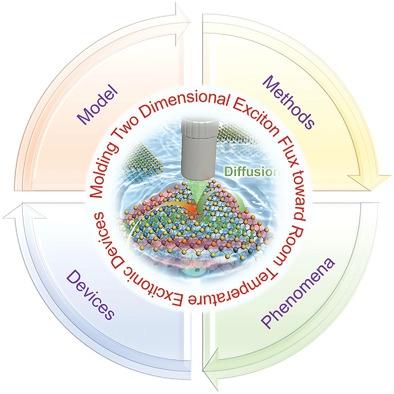当前位置:
X-MOL 学术
›
Adv. Mater. Technol.
›
论文详情
Our official English website, www.x-mol.net, welcomes your
feedback! (Note: you will need to create a separate account there.)
Molding 2D Exciton Flux toward Room Temperature Excitonic Devices
Advanced Materials Technologies ( IF 6.4 ) Pub Date : 2022-03-15 , DOI: 10.1002/admt.202200032
Pengfei Qi 1 , Yuchen Dai 2 , Yang Luo 3 , Guangyi Tao 4 , Wenqi Qian 1 , Zeliang Zhang 1 , Zhi Zhang 1 , Tian Hao Zhang 4 , Lie Lin 1 , Weiwei Liu 1 , Zheyu Fang 2
Advanced Materials Technologies ( IF 6.4 ) Pub Date : 2022-03-15 , DOI: 10.1002/admt.202200032
Pengfei Qi 1 , Yuchen Dai 2 , Yang Luo 3 , Guangyi Tao 4 , Wenqi Qian 1 , Zeliang Zhang 1 , Zhi Zhang 1 , Tian Hao Zhang 4 , Lie Lin 1 , Weiwei Liu 1 , Zheyu Fang 2
Affiliation

|
Devices operating with excitons have promising prospects for overcoming the dilemma of response time and integration in current generation of electron- or/and photon-based elements and devices. In combination with the advantages of emerging twistronics and valleytronics, the atomically thin transition metal dichalcogenide semiconductors open up new opportunities for pursuing practical excitonic devices, where the strong exciton binding energy enables operating exciton at room temperature. The essential and foremost step toward exciton devices is the control of spatiotemporal exciton flux, which is density-dependent and affected by the complex many-body interactions. It can be effectively controlled by the strain, electric field, electron-doping, and local dielectric environment. Intriguingly, exotic phenomena such as exciton condensation, electron-hole liquid, exciton Hall effects, and exciton halo effects can be occurred in 2D exciton system, providing new possibilities for excitonic devices. Up to now, the proof-of-principle of room temperature exciton devices, including excitonic switching and transistor, exciton guides, and excitonic nanolaser, have been realized. Here the authors review the recent advances in molding 2D exciton flux from basic principle, manipulation, exotic phenomena to promising applications and discuss the opportunities and challenges in pushing the frontiers of room temperature excitonic devices.
中文翻译:

将二维激子通量成型为室温激子器件
使用激子工作的器件在克服当前一代基于电子或/和光子的元件和器件中响应时间和集成的困境方面具有广阔的前景。结合新兴的双电子学和谷电子学的优势,原子级薄的过渡金属二硫属化物半导体为追求实用的激子器件开辟了新的机会,其中强大的激子结合能使激子能够在室温下运行。激子器件的基本和最重要的一步是控制时空激子通量,它依赖于密度并受复杂的多体相互作用的影响。它可以通过应变、电场、电子掺杂和局部介电环境进行有效控制。有趣的是,激子凝聚等奇异现象,电子空穴液体、激子霍尔效应和激子光晕效应可以在二维激子系统中发生,为激子器件提供了新的可能。到目前为止,室温激子器件的原理验证已经实现,包括激子开关和晶体管、激子波导和激子纳米激光器。在这里,作者回顾了二维激子通量成型的最新进展,从基本原理、操作、奇异现象到有前景的应用,并讨论了推动室温激子器件前沿的机遇和挑战。激子波导和激子纳米激光器已经实现。在这里,作者回顾了二维激子通量成型的最新进展,从基本原理、操作、奇异现象到有前景的应用,并讨论了推动室温激子器件前沿的机遇和挑战。激子波导和激子纳米激光器已经实现。在这里,作者回顾了二维激子通量成型的最新进展,从基本原理、操作、奇异现象到有前景的应用,并讨论了推动室温激子器件前沿的机遇和挑战。
更新日期:2022-03-15
中文翻译:

将二维激子通量成型为室温激子器件
使用激子工作的器件在克服当前一代基于电子或/和光子的元件和器件中响应时间和集成的困境方面具有广阔的前景。结合新兴的双电子学和谷电子学的优势,原子级薄的过渡金属二硫属化物半导体为追求实用的激子器件开辟了新的机会,其中强大的激子结合能使激子能够在室温下运行。激子器件的基本和最重要的一步是控制时空激子通量,它依赖于密度并受复杂的多体相互作用的影响。它可以通过应变、电场、电子掺杂和局部介电环境进行有效控制。有趣的是,激子凝聚等奇异现象,电子空穴液体、激子霍尔效应和激子光晕效应可以在二维激子系统中发生,为激子器件提供了新的可能。到目前为止,室温激子器件的原理验证已经实现,包括激子开关和晶体管、激子波导和激子纳米激光器。在这里,作者回顾了二维激子通量成型的最新进展,从基本原理、操作、奇异现象到有前景的应用,并讨论了推动室温激子器件前沿的机遇和挑战。激子波导和激子纳米激光器已经实现。在这里,作者回顾了二维激子通量成型的最新进展,从基本原理、操作、奇异现象到有前景的应用,并讨论了推动室温激子器件前沿的机遇和挑战。激子波导和激子纳米激光器已经实现。在这里,作者回顾了二维激子通量成型的最新进展,从基本原理、操作、奇异现象到有前景的应用,并讨论了推动室温激子器件前沿的机遇和挑战。

































 京公网安备 11010802027423号
京公网安备 11010802027423号